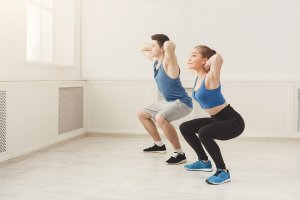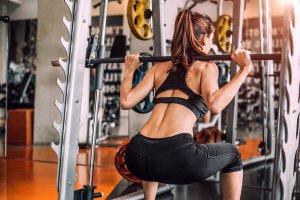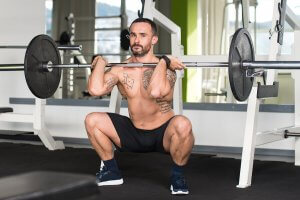Deep Squat: Benefits of Including it in your Workout

The deep squat is an amazing exercise to strengthen your thighs. When doing a deep squat, your hips should be lower than your knee joints. As you can imagine, this exercise helps us develop and strengthen almost all muscle fibers in the body.
As this exercise engages your whole body, you need to make sure you’re holding an appropriate position throughout your movements. If your joints are placed in an incorrect position, you could severely injure yourself. In this article, we’ll explain how to do a deep squat correctly, and how your muscles engage while doing it.
What muscles are involved in the deep squat?
As we mentioned before, knowing the biomechanics of this movement will be fundamental for correct execution. The muscles involved in this exercise are the following:
- Quadriceps: this is the largest muscle in the body. The quadriceps consists of four segments: the rectus femoris -which has its insertion in the iliac spine-, the vastus lateralis, the vastus intermedius, and the vastus medialis. These have their insertion in the femur and reach the kneecap.
- Femoral: this muscle is opposite to the quadriceps. When doing a deep squat, the femoral muscle is in charge of controlling the rate of descent, and there lies its importance for this exercise.
- Other muscles: although less important, they also influence the way you control your squat. A deep squat involves the hamstrings, the adductors, and, of course, gluteus maximus and spinal erectors.

Deep squat vs. traditional squat
Next, we’ll review the advantages of practicing the deep squat over the traditional squat.
- The cruciate ligaments are very important in many sports disciplines, so you should take proper care of them. In this sense, the deep squat is less harmful to them than a traditional squat. These ligaments are, as we know, keys to knee stability. Whenever we can, we must protect them from the risk of injury. Remember these injuries can entail long recoveries and even surgery.
- Compared to the traditional squat, the deep squat develops your muscles faster and better, gaining more strength in your quads in a shorter amount of time. This happens because the lower your body goes, the harder your quadriceps work.
- Our gluteal muscles will work harder and become stronger. Usually, these muscles are engaged only when we sprint. Luckily, deep squats work gluteal muscles as much as going for a short run.
Benefits of practicing deep squats
The deep squat is, undoubtedly, the best exercise for working out your legs. Still, you must remember you need to go lower than 90 degrees. This exercise reports many benefits for your body, in addition to those mentioned before. These benefits include:
- It improves the mobility of the lower body muscles.
- In the deep squat, we work the muscle to its very core, which helps reduce the risk of fibrillary rupture.
- As we strengthen our knees, hips, and ankles, our bodies will be able to withstand more weight. The longer you practice the deep squat, the less stiff your tissues will be.
- Practicing this exercise will ensure that your joints, cartilage, and meniscus are worked properly. In the long run, this will reduce the risk of injury even when practicing other sports.
- Muscle hypertrophy is a constant concern for many athletes. Recent studies have shown that regular squats lead to muscle hypertrophy, whereas deep squats don’t.

- Practicing deep squats will improve your lumbar stabilization, something fundamental when it comes to preventing injuries.
- Lordosis can be very painful. Fortunately, deep squats work as pain relievers, releasing the tension from the lumbar area. When you squat low, the pelvis rotates back, which allows the spine to lengthen, effectively diminishing the pain.
Now you know all the benefits of doing a deep squat. Make sure you maintain a proper position to avoid injuries. Now, what are you waiting for to include this exercise in your routine?
The deep squat is an amazing exercise to strengthen your thighs. When doing a deep squat, your hips should be lower than your knee joints. As you can imagine, this exercise helps us develop and strengthen almost all muscle fibers in the body.
As this exercise engages your whole body, you need to make sure you’re holding an appropriate position throughout your movements. If your joints are placed in an incorrect position, you could severely injure yourself. In this article, we’ll explain how to do a deep squat correctly, and how your muscles engage while doing it.
What muscles are involved in the deep squat?
As we mentioned before, knowing the biomechanics of this movement will be fundamental for correct execution. The muscles involved in this exercise are the following:
- Quadriceps: this is the largest muscle in the body. The quadriceps consists of four segments: the rectus femoris -which has its insertion in the iliac spine-, the vastus lateralis, the vastus intermedius, and the vastus medialis. These have their insertion in the femur and reach the kneecap.
- Femoral: this muscle is opposite to the quadriceps. When doing a deep squat, the femoral muscle is in charge of controlling the rate of descent, and there lies its importance for this exercise.
- Other muscles: although less important, they also influence the way you control your squat. A deep squat involves the hamstrings, the adductors, and, of course, gluteus maximus and spinal erectors.

Deep squat vs. traditional squat
Next, we’ll review the advantages of practicing the deep squat over the traditional squat.
- The cruciate ligaments are very important in many sports disciplines, so you should take proper care of them. In this sense, the deep squat is less harmful to them than a traditional squat. These ligaments are, as we know, keys to knee stability. Whenever we can, we must protect them from the risk of injury. Remember these injuries can entail long recoveries and even surgery.
- Compared to the traditional squat, the deep squat develops your muscles faster and better, gaining more strength in your quads in a shorter amount of time. This happens because the lower your body goes, the harder your quadriceps work.
- Our gluteal muscles will work harder and become stronger. Usually, these muscles are engaged only when we sprint. Luckily, deep squats work gluteal muscles as much as going for a short run.
Benefits of practicing deep squats
The deep squat is, undoubtedly, the best exercise for working out your legs. Still, you must remember you need to go lower than 90 degrees. This exercise reports many benefits for your body, in addition to those mentioned before. These benefits include:
- It improves the mobility of the lower body muscles.
- In the deep squat, we work the muscle to its very core, which helps reduce the risk of fibrillary rupture.
- As we strengthen our knees, hips, and ankles, our bodies will be able to withstand more weight. The longer you practice the deep squat, the less stiff your tissues will be.
- Practicing this exercise will ensure that your joints, cartilage, and meniscus are worked properly. In the long run, this will reduce the risk of injury even when practicing other sports.
- Muscle hypertrophy is a constant concern for many athletes. Recent studies have shown that regular squats lead to muscle hypertrophy, whereas deep squats don’t.

- Practicing deep squats will improve your lumbar stabilization, something fundamental when it comes to preventing injuries.
- Lordosis can be very painful. Fortunately, deep squats work as pain relievers, releasing the tension from the lumbar area. When you squat low, the pelvis rotates back, which allows the spine to lengthen, effectively diminishing the pain.
Now you know all the benefits of doing a deep squat. Make sure you maintain a proper position to avoid injuries. Now, what are you waiting for to include this exercise in your routine?
All cited sources were thoroughly reviewed by our team to ensure their quality, reliability, currency, and validity. The bibliography of this article was considered reliable and of academic or scientific accuracy.
- Bloomquist K, Langberg H, Karlsen S, Madsgaard S, Boesen M, Raastad T. Effect of range of motion in heavy load squatting on muscle and tendon adaptations. Eur J Appl Physiol. 2003
- Chandler T; Wilson G; Stone M. The effect of the squat exercise on knee stability. Medicine and Science in Sports and Exercise. 21(3)299-303. 1989.
- Escamilla RF; Fleisig GS; Zheng N; Barrentine SW; Wilk KE and Andrews JR. 1998 Biomechanics of the knee during closed kinetic chain and open kinetic chain exercises. Medicine and Science in Sports and Exercise. 30:556 – 569. 1998
- Escamilla RF; Fleisig GS; Zheng N; Barrentine SW; Wilk K; Andrews JR; Bergemann BW; Moorman CT. 2001. Effects of technique variations on knee biomechanics during the squat and leg press. Medicine and Science in Sports and Exercise. 33:1552 – 1566. 2001
This text is provided for informational purposes only and does not replace consultation with a professional. If in doubt, consult your specialist.








